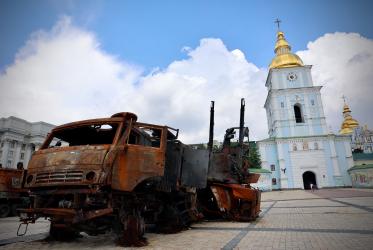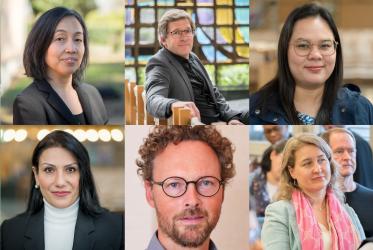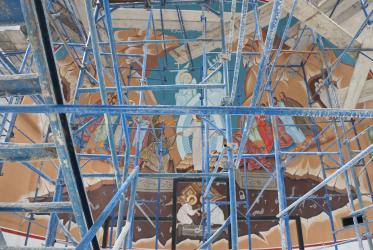By Odair Pedroso Mateus*
Few moments in the early history of the World Council of Churches have embodied and conveyed the spirit of the modern ecumenical movement as vividly as the service celebrated at Saint Peter’s Cathedral, Geneva, 20 February 1946, less than one year after the end of World War II.
Last Saturday, 20 February, I arrived half an hour earlier at the cathedral to attend a prayer service in remembrance of that event. Seventy-five years later day-by-day, I wanted to take a few moments before the service to pay a new visit to a marble tablet on the cathedral wall commemorating “the first ecumenical service after the Second World War.”
The marble tablet was inaugurated ten years later, in April 1956. The idea of commemorating the 10th anniversary of the 1946 service was initiated by the Geneva banker Gustave Hentsch. Together with another Geneva Protestant banker, Georges Lombard, Hentsch pioneered the establishment in 1946 of the Ecumenical Loan Fund, what is today the non-profit, micro-finance foundation ECLOF International.

The marble tablet commemorating the first ecumenical worship after World War II.
After the name and origin of the celebrants of 1946, most of them from countries that had been at war the previous years, the marble tablet gives two biblical references. The first, certainly addressed to the churches whose divisions did not help to prevent the reign of violence, is Luke 15:7: “there will be more joy in heaven over one sinner who repents than over ninety-nine righteous persons who need no repentance.”
The second biblical reference is from the letter that from those days to the present has played a foundational role in the biblical-theological case for the search for unity: “For he is our peace; in his flesh he has made both groups into one and has broken down the dividing wall, that is, the hostility between us (…) that he might create in himself one new humanity in place of the two, thus making peace…” (Ephesians 2: 14-15).
As I crossed the central aisle of the nave, listening to the melancholic sound of the pandemic’s silence, I dreamed. I was now a young theological student, selected to be a steward in that 1946 meeting of the Provisional Committee of the future World Council of Churches. I had just heard the exciting news that in October of that year the Provisional Committee would open a school of ecumenical formation in an old château 20 kilometres away from Geneva. During a coffee break, I had heard that in a recent visit to the place, Robert Mackie and Visser ‘t Hooft had found that “the disorganised old house with its innumerable pictures of Napoleon” did not seem very inviting. However, the idea that the place, called Bossey, could look gorgeous “in the spring and summer” had finally convinced them.
Then in my dream, I suddenly held in my hands a yellowish page of my steward’s diary. It smelled like locked rooms of old libraries. It was dated “Febr 20, 1946, 23:45”:
“My steward duty tonight took me first of all from the Hotel des Bergues to Saint Peter’s Cathedral. Some delegates attending a reception offered by the Federation of Swiss Protestant Churches at the Hotel had to find their way to the Cathedral for the service, which would start at 20:30.
At Saint Peter’s, my task was to make sure that in a packed church all delegates from around the world who are attending the meeting of the Provisional Committee of the World Council of Churches would receive the order of worship. The long entrance procession – I counted no less than forty people - was led by Rev. Charles Cellerier, the moderator of the Venerable Company of Pastors of Geneva founded by Calvin, and by the photogenic Rev. Marc Boegner, the president of the French Protestant Federation.

The WCC has gathered for many ecumenical prayer services at the cathedral through the years. Here, representatives of churches worldwide gathered for a service of celebration to mark the 70th anniversary of the World Council of Churches on 17 June 2018.
Boegner and Cellerier were followed the Lord-Archbishop of Canterbury, Geoffrey Fisher, who conducted the service, and Metropolitan Germanos of Thyatira. Metropolitan Germanos was in charge of the biblical readings. He could have celebrated thirty-five years of ecumenical engagement together with his old friend John Mott. The procession included Archimandrite Cassian of Mont Athos and the renowned Prof. Georges Florovsky of the Institut Saint Serge in Paris.
Since Calvin’s days, the Reformed in French-speaking Switzerland and the French Huguenots, following an ancient Jewish tradition, have placed the singing of the psalms a capela at the heart of worship so that the faithful would learn to pray them by heart. Tonight was no exception. A choir – called “Le Choeur de la Maîtrise Protestante” – sang a psalm before and after each sermon. I still can hear the notes of Psalm 8, rhymed by Clément Marot and probably harmonised by Claude Goudimel: Domine dominus noster quam admirabile est nomen tuum…
Now I come to what was for me tonight a sort of ecumenical epiphany. Although the service started rather late, at 20:30, there were three short sermons. The three addresses were given by three people who had been in prison during the war because of active resistance to oppression. The three witnessed to the consolation, communion and encouragement they experienced in prison thanks to the intercessions of Christians from other churches and countries.
At the end of the last message, I suddenly realised that despite divisions among the churches there is a fundamental oneness in Christ that no war can destroy because it’s God’s gift; and because it’s God’s gift, it has to be made manifest in, and to, and for the world. That is the spirit of the ecumenical movement! The church universal was visible tonight!
The first preacher was Rev. Dr Chester S. Miao. The editor of Christian Voices in China, he is preparing a report on “The Christian Church in ‘Occupied’ China.” Miao is the general secretary of the China Christian Council. He said that he was put in prison in Japanese occupied Shanghai during the war. He told of how, occasionally, he and his Japanese gaoler discovered that both were Christians and, when they discovered it, they would kneel in prayer together in his prison cell.
Rev. Miao was followed by Bishop Eivind Berggrav, the leader of the Lutheran Church in Norway. During the war, Bishop Berggrav was kept under house arrest in the forest because of his prominent role in the church resistance against German occupation. He gracefully preached in German. Towards the end of his preaching, Bishop Berggrav told the audience what he called “a detail of his captivity.”
A peasant’s wife was determined to offer the bishop a bottle of milk. The soldiers placed at the entrance of the bishop’s chalet were probably taking a nap due to the summer heat. In any case, she managed to reach the kitchen window and whispered to the Bishop as she passed him the bottle: “Bishop, my husband was illegally listening to the T.S.F. yesterday and heard the Archbishop of Canterbury praying for you.” Berggrav concluded: ‘The woman immediately disappeared, but her messaged remained with me. It looks as though God had knocked down all the walls…’
The last address was by Rev. Martin Niemöller, one of leaders of the confessing church in Germany, which resisted the attempts of the Nazi regime to interfere in the life of the church in order to oblige it to comply with the anti-Semitic policies of the State. Niemöller was not only in prison but also in solitary confinement. The citizen of a country that invaded France, he gracefully preached in French.
Niemöller told a crowded cathedral about the day his father visited him in prison. ‘I will never forget these words from my old father when for the last time he visited at the Gestapo office in the concentration camp of Oranienburg: My son, the esquimos from Canada and the Batak from Sumatra send you their greetings and are praying for you. Niemöller went on to say that during his years in prison that knowledge had kept him ‘not only sane but even joyful.’
For a young Protestant often used to the reality of the local congregation and the abstraction of the church universal, this was indeed an ecumenical epiphany. Christian divisions are sin and lead to violence. The search for the manifestation of the church universal is gospel obedience and leads to peace.
I hope the divided churches will not wait until the twenty-first century in order to put in practice the call to visible unity. I can hardly imagine the idea that one day they may gather again to remember what happened tonight. Would that mean that in the distant future divided Christians will have forgotten the disasters related to their past divisions like crusades, religious wars and indeed two world wars? Is not the movement for Christian unity an act of repentance for violence related to schisms and for dechristianisation inspired by Christian counter-witness? Is not the ecumenical movement an act of peace, of rebellion against the nationalism that uses confessional divisions among Christians to place ethnic Christianity above the mutual belonging and mutual accountability of the church universal?”
The diary page suddenly vanished in the mist. Rev. Emmanuel Rolland, the senior pastor of the cathedral, brought me back to reality. It is time to get ready for the entrance procession. Rev. Blaise Menu, who moderates the Company of Pastors and Deacons, replaces Charles Cellerier and leads it, and I am asked to join him as Marc Boegner joined Cellerier in 1946.
Boegner, whom Israel made a righteous among the nations in 1988, did not write an autobiography that would have included his ecumenical engagement from Edinburgh 1910 to Second Vatican Council in the 1960s. On the contrary. He wrote a book about the ecumenical imperative, L’Exigence oecuménique, which gave him the opportunity to talk about his life. Boegner never forgot February 1946: “More exciting still would be the ecumenical service celebrated in the evening of the following day at Saint-Pierre. The crowd was impressive to watch. Bishop Berggrav of Oslo preached in Germand and Niemöller in French. It was an ecumenical act of great value.” It was the ecumenical spirit at Calvin’s Cathedral.

Exterior view of the cathedral, 17 June 2018.
*Rev. Dr Odair Pedroso Mateus is interim deputy general secretary of the World Council of Churches; director of the WCC Commission on Faith and Order; and lecturer at the WCC Ecumenical Institute at Bossey.
The author dedicates this text to Rev. Romi Bencke, the general secretary of the National Council of Christian Churches of Brazil, CONIC, in gratitude for her courageous and inspiring ecumenical engagement.







